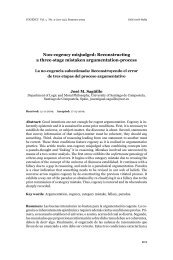Cogency v2 n2
Cogency v2 n2
Cogency v2 n2
You also want an ePaper? Increase the reach of your titles
YUMPU automatically turns print PDFs into web optimized ePapers that Google loves.
COGENCY Vol. 2, N0. 2, Spring 2010<br />
just this way? Or should we say that when we use it, it is an elliptical<br />
sentence, a shorthand for “Bring me a brick”?<br />
Wittgenstein introduces the question of the meaning of the expression<br />
“Brick!” as it occurs in the simplified language and as it occurs in our own<br />
language, but it is not Wittgenstein’s voice that raises the question of meaning.<br />
The last two questions in this excerpt are just the beginning of a run of<br />
8 consecutive questions, peppering the voice articulating the Augustinian<br />
model from many different directions. There may be different voices asking<br />
questions, but there is a single voice that is expected to answer them. Augustine,<br />
or Wittgenstein as his stand-in, is being interrogated.<br />
The Investigations also begins with Augustine’s account of language as<br />
essentially a system of names and language-acquisition as beginning with<br />
(if not consisting entirely of) learning names. Two simple languages and<br />
situations are then considered, the builders’ slab language from the Brown<br />
Book and a shopper’s language, elements from which are later merged. The<br />
builders’ example is again introduced right away, in §2, and it is the focus of<br />
sections 6-10, and particularly 19-20, where the interrogation in the Brown<br />
Book undergoes a metamorphosis into a critical discussion.<br />
The stage is set for this transformation in the very first section when<br />
Wittgenstein bids us think of the way a shopkeeper uses language in order<br />
to fill a customer’s shopping list. A labeled drawer locates the kind of items<br />
that are on the list, a color-chart provides the information as which instances<br />
of that kind are satisfactory, and reciting the memorized sequence of counting<br />
numbers tells the shopkeeper when enough of the indicated items have<br />
been selected. This story is immediately followed by a dialogue:<br />
–It is in this and similar ways that one operates with words.–“But how<br />
does he know where and how he is to look up the word ‘red’ and what he<br />
is to do with the word ‘five’?”–Well, I assume that he acts as I have described.<br />
Explanations have to come to an end somewhere.–But what is<br />
the meaning of the word “five”?–No such thing was in question here,<br />
only how the word “five” is used. (§1)<br />
Notice that in the Investigations passage, quotation marks are used to<br />
indicate the new voice when it initially appears (“But how do you know…?”),<br />
34








